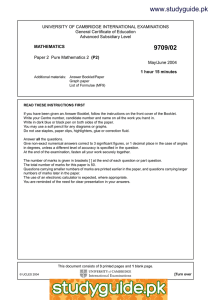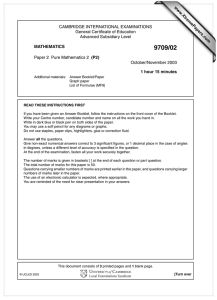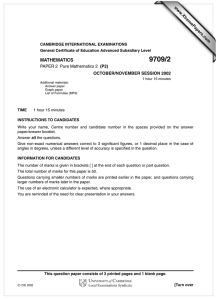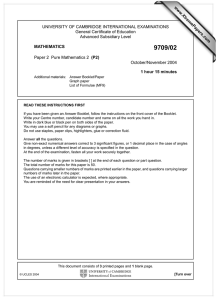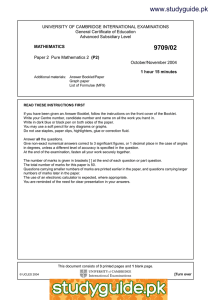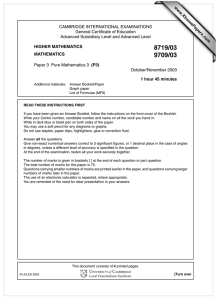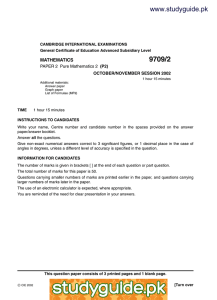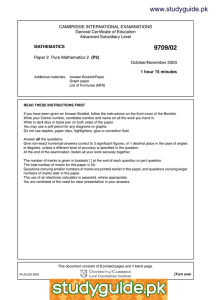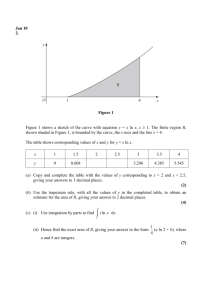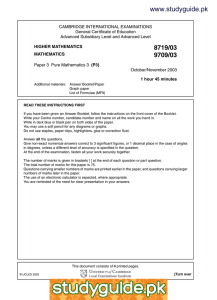www.XtremePapers.com
advertisement
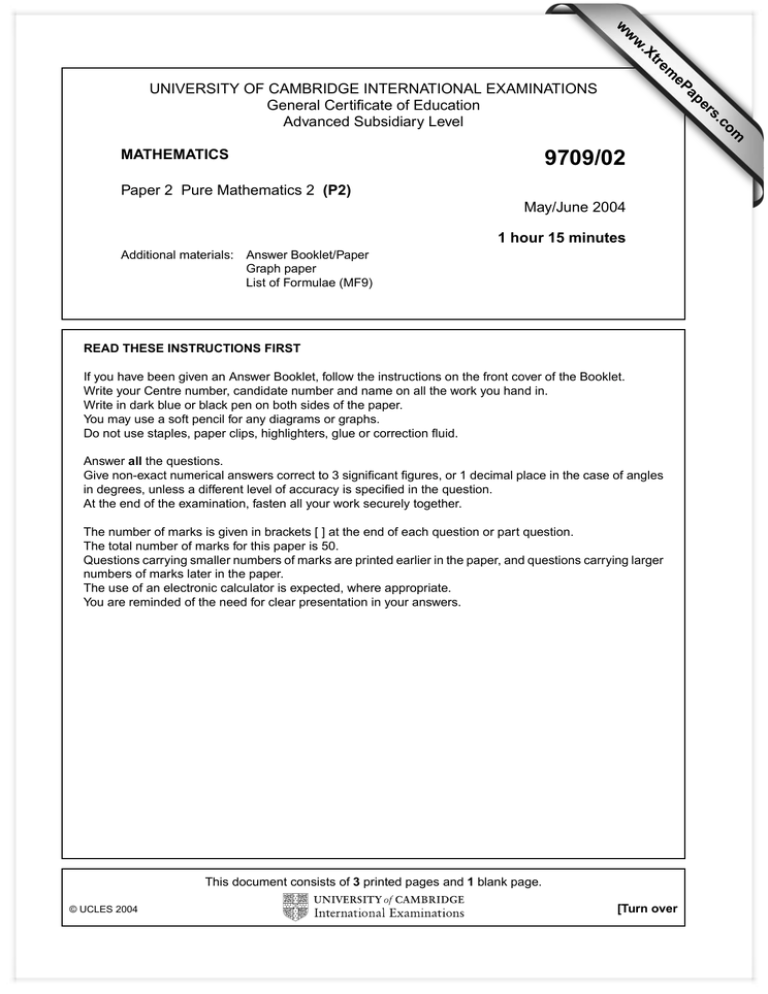
w w ap eP m e tr .X w om .c MATHEMATICS s er UNIVERSITY OF CAMBRIDGE INTERNATIONAL EXAMINATIONS General Certificate of Education Advanced Subsidiary Level 9709/02 Paper 2 Pure Mathematics 2 (P2) May/June 2004 1 hour 15 minutes Additional materials: Answer Booklet/Paper Graph paper List of Formulae (MF9) READ THESE INSTRUCTIONS FIRST If you have been given an Answer Booklet, follow the instructions on the front cover of the Booklet. Write your Centre number, candidate number and name on all the work you hand in. Write in dark blue or black pen on both sides of the paper. You may use a soft pencil for any diagrams or graphs. Do not use staples, paper clips, highlighters, glue or correction fluid. Answer all the questions. Give non-exact numerical answers correct to 3 significant figures, or 1 decimal place in the case of angles in degrees, unless a different level of accuracy is specified in the question. At the end of the examination, fasten all your work securely together. The number of marks is given in brackets [ ] at the end of each question or part question. The total number of marks for this paper is 50. Questions carrying smaller numbers of marks are printed earlier in the paper, and questions carrying larger numbers of marks later in the paper. The use of an electronic calculator is expected, where appropriate. You are reminded of the need for clear presentation in your answers. This document consists of 3 printed pages and 1 blank page. © UCLES 2004 [Turn over 2 1 Given that 2x = 5y , use logarithms to find the value of 2 The sequence of values given by the iterative formula x correct to 3 significant figures. y [3] 306 1 xn+1 = 4xn + 4 , 5 xn with initial value x1 = 3, converges to α . (i) Use this iterative formula to find α correct to 3 decimal places, showing the result of each iteration. [3] (ii) State an equation satisfied by α , and hence show that the exact value of α is 3 4 √ 5 306 . [2] The cubic polynomial 2x3 + ax2 − 13x − 6 is denoted by f(x). It is given that (x − 3) is a factor of f(x). (i) Find the value of a. [2] (ii) When a has this value, solve the equation f(x) = 0. [4] (i) Express 3 sin θ + 4 cos θ in the form R sin(θ + α ), where R > 0 and 0◦ < α < 90◦ , giving the value [3] of α correct to 2 decimal places. (ii) Hence solve the equation 3 sin θ + 4 cos θ = 4.5, giving all solutions in the interval 0◦ ≤ θ ≤ 360◦ , correct to 1 decimal place. (iii) Write down the least value of 3 sin θ + 4 cos θ + 7 as θ varies. 9709/02/M/J/04 [4] [1] 3 5 The diagram shows the part of the curve y = xe−x for 0 ≤ x ≤ 2, and its maximum point M . (i) Find the x-coordinate of M . [4] (ii) Use the trapezium rule with two intervals to estimate the value of 2 xe−x dx, 0 giving your answer correct to 2 decimal places. [3] (iii) State, with a reason, whether the trapezium rule gives an under-estimate or an over-estimate of [1] the true value of the integral in part (ii). 6 The parametric equations of a curve are x = 2t + ln t, 4 y=t+ , t where t takes all positive values. (i) Show that dy t2 − 4 = . dx t(2t + 1) [3] (ii) Find the equation of the tangent to the curve at the point where t = 1. [3] (iii) The curve has one stationary point. Find the y-coordinate of this point, and determine whether this point is a maximum or a minimum. [4] 7 (i) By expanding cos(2x + x), show that cos 3x ≡ 4 cos3 x − 3 cos x. [5] (ii) Hence, or otherwise, show that 1 π 2 0 cos3 x dx = 23 . 9709/02/M/J/04 [5] 4 BLANK PAGE 9709/02/M/J/04
